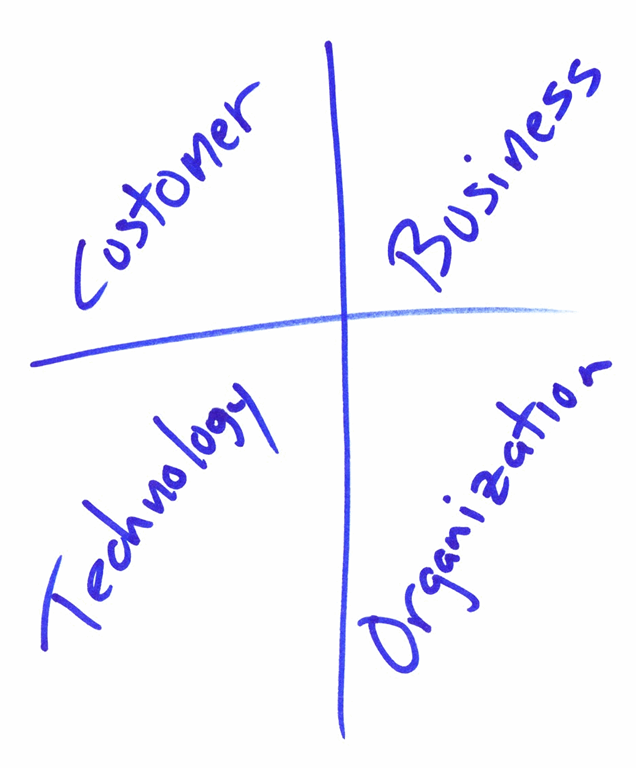CBTO is a mental model for driving clarity of thought in business. It asserts there are four perspectives (Customer, Business, Technology, and Organization).
CBTO = Customer + Business + Technology + Organization
Customer (Product)
Who is the customer? How do we segment customers? How many customers are there? What do customers want? What pain do customers currently feel?
Customer in CBTO is synonymous with Product. What is the customer experience we are working backward from? What is the product? What features are important? How are those features crafted and prioritized?
Everyone in the organization needs to take this perspective, but generally, folks who consider themselves Product Managers and UX Designers tend to index very highly on this perspective.
Business (Industry)
Why are we doing this? Is there a new strategy, or does what we are doing accrue to an existing strategy? Is there money to be made? If so, how much and when? What deals do we need to make to deliver the customer experience? What are inputs and outputs for the business? How do we measure success?
Business in CBTO is synonymous with Industry. Who can we partner with? What are industry trends? Who are our competitors?
The Business perspective is typically where folks with business backgrounds (e.g., MBAs) are the strongest.
Technology (Execution)
What do we need to invent to make the proposed customer experience true? What needs to be built or bought or borrowed? What shoulders of giants do we stand on?
Technology in CBTO is synonymous with Execution. How are we going to execute? What’s our execution model (e.g., agile or waterfall)? How do we operate our services? How do we ensure operational excellence?
The Technology perspective is usually the strongest with engineering leaders, like SDMs or Technical Program Managers. Generally, engineering is where the center of gravity in most high-performing organizations is, simply because engineers are the only people who actually do work that directly impacts customers.
Organization (People)
How are we organized? Functionally? Or matrixed? How will we recruit and hire the best? How do we ensure everyone is set up for success in their careers? What’s our compensation and reward system? What are our company (or group) tenets or Leadership Princples?
Organization in CBTO is synonymous with People.
All people managers must index high on the organizational perspective. Human Resources (HR) generally is entirely focused on O.
How to use CBTO
Use CBTO to gain clarity on a broad range of topics. For example:
- If you are designing an organization, you can use it to determine if you have the right balance of leadership in place to be successful. The best product organizations have a balance of excellence across all four perspectives.
- When reporting on status (e.g., a weekly status report), use CBTO to add structure to your report. What did you do this week focused on defining the product experience (C)? Meeting with external partners (B)? Progress towards shipping (T)? Being a manager or mentor (O)?
- When considering a career move, ask yourself where you are strong and weak relative to these perspectives. Then decide which of them you’d like to be putting more energy into in your next role.
- When interviewing leaders, ask them to stack rank their relative strengths and weakness across these four perspectives. If you are hiring someone to be an engineering leader and their stack is “BOCT,” they probably won’t make a very good engineering leader.
- I’ve used CBTO to categorize many of the posts I’ve written on this blog over the years. These links take you to those focusing on each perspective: Customer, Business, Technology, Organization.
Frameworks and mental models like CBTO can help create clarity of thought. There’s no perfect framework, but I have found CBTO to work pretty well for me. What do you think?
Footnote: I invented CBTO as a derivation of BXT, coined by J Allard at Microsoft. As Robbie Bach notes in his book Xbox Revisited:
 BXT = Business + eXperience + Technology
BXT = Business + eXperience + Technology
- I hated that B (Business) came first. The Customer ALWAYS comes first, not the Business (or Technology).
- While the “X” was cute and sexy in an Xbox sort-of-way, the word “experience” fails to capture the most important thing: The Customer. Building experiences is not the end but a means to the end.
- BXT completely misses a critical dimension of building great stuff for customers: The people who build and how they are organized.
This led me to invent CBTO. The name is certainly not as sexy sounding as BXT, but it is still easy to remember.

















 RSS - Posts
RSS - Posts
Very interesting article, traditional business always focused on the business first and that’s how it’s taught in b-schools and not customer. It’s only when saw technology company disrupting and innovating on behalf of customers we are that shift. Like the way it is captured and laid out by you
Quite a useful framework, especially the application to individuals as well as teams.
Do you think the representative questions under Business need to expand to cover more financial execution beyond the Product Strategy set you include? I’d appreciate your perspective on what some of those would be.
Yes, they should include financial execution. E.g. “Do we have a budget? What mechanisms will we use to ensure we stay on budget? What are tax implications? How do we price what we’re building? Fremium? Subscription? Margins?” Does that help?
There a lot of parallelism/symmetry between CBTO and the 4 perspectives in Kaplan& Norton’s Strategy Maps (https://www.thriftbooks.com/w/strategy-maps-converting-intangible-assets-into-tangible-outcomes_robert-s-kaplan_david-p-norton/254224/#isbn=1591391342&idiq=5063642).
Here’s a real-life example of a strategy maps…
https://hyperonomy.com/2023/01/01/strategy-maps-real-life-example/
Side comment: I’ve done some interesting things graphitizing Amazon’s Leadership Principles:
https://hyperonomy.com/2017/05/08/amazons-principles/